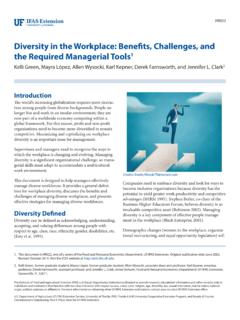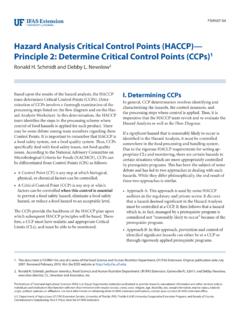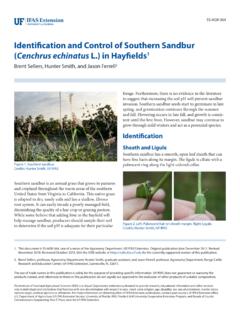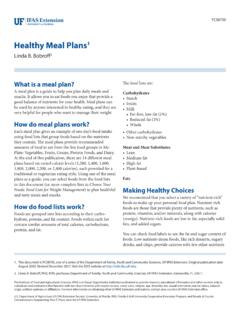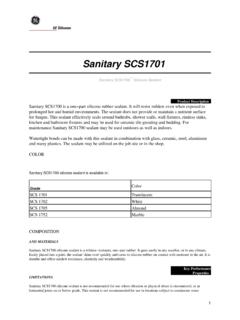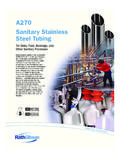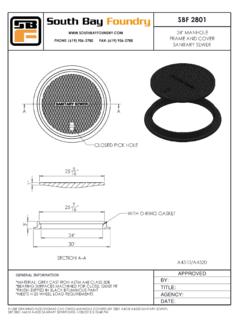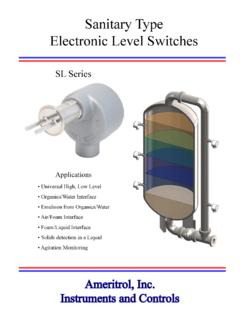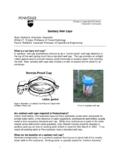Transcription of Sanitary Design and Construction of Food …
1 FSHN0408 Sanitary Design and Construction of food processing and handling Facilities1 Ronald H. Schmidt and Daniel J. document is FSHN0408, one of a series of the food Science and Human Nutrition Department, UF/IFAS Extension. Original publication date May 2005. Reviewed February 2017. Visit the EDIS website at H. Schmidt, professor and food science Extension specialist, food Science and Human Nutrition Department; and Daniel J. Erickson, Harold Wainness and Associates; UF/IFAS Extension, Gainesville, FL 32611. The Institute of food and Agricultural Sciences (IFAS) is an Equal Opportunity Institution authorized to provide research, educational information and other services only to individuals and institutions that function with non-discrimination with respect to race, creed, color, religion, age, disability, sex, sexual orientation, marital status, national origin, political opinions or affiliations.
2 For more information on obtaining other UF/IFAS Extension publications, contact your county s UF/IFAS Extension Department of Agriculture, UF/IFAS Extension Service, University of Florida, IFAS, Florida A & M University Cooperative Extension Program, and Boards of County Commissioners Cooperating. Nick T. Place, dean for UF/IFAS ensure safe food and adequate sanitation programs, the facility and surroundings in which food processing and handling operations are conducted must be designed and constructed with Sanitary Design principles in mind. Many existing facilities do not have optimum Sanitary Design and Construction . Certain adjustments and/or renovations, where feasible, may be necessary. While often discussed separately, Sanitary Construction and Sanitary Design are inter-related objectives of designing and constructing a Sanitary food handling facility are to minimize harborages, eliminate the entrance of pests and other sources of contamination.
3 To Design and build in features that protect the food product from contamination should be the ultimate goal of planners and designers. The Sanitary Design features of a facility should be thoroughly evaluated on a periodic basis. Such evaluation should include the following: Premises, surroundings, and building site; Exterior building Design and Construction features; Interior building Design and Construction features; and Operational flow and facility , Surroundings, and Building SiteThe objectives regarding Sanitary building site and exterior surroundings are to use every effort and means possible to minimize: harborages and infestations of vermin ( , rodents,insects, birds, other pests), mold and mildew, and micro-organisms; and potential for contamination with environmental role of rodents, insects, birds, and other pests ( , frogs, reptiles) in spreading foodborne pathogens has been well documented.
4 It is imperative that an adequate pest control management program is in place for food processing and handling facilities . While it is possible, with good practices and due diligence, to self manage pests, it is recommended that the services of a reputable pest manage-ment supplier be obtained. It is also a good plan to identify an employee that is assigned to work with the pest manage-ment supplier with regard to the location of bait stations, tracking trap and station activity, chemical storage, and the observation of proper pest control procedures. Proper records and documentation of a pest control program is important to the success of an overall sanitation program. The topics discussed below regarding the location of traps and bait stations, maintenance of outside surroundings, 2 Sanitary Design and Construction of food processing and handling Facilitiesand limitation of pest entry into buildings are all part of a successful pest management with real estate, an important feature of a Sanitary food facility is location, location, location.
5 Ideally, a facility should be located away from any contamination source ( , chemical plant, sewage treatment facility, salvage yard, livestock housing, cow pasture, or body of water). For many existing facilities , the location may not be in the control of the facility management as other industries may have moved in around the food facility. If, in the evaluation of the facility, it is found that sources of contamination are adjacent or near the building, special precautions are necessary to keep odors and contaminants from entering the yard or facility. When building a new facility, an inquiry should be made regarding the previous occupants and the type of operations previously conducted at that Condition, Preparation, and MaintenanceWhen preparing a new site for Construction , the site should be thoroughly cleaned of any potentially toxic materials and graded for appropriate drainage and prevention of standing or pooled water.
6 Storm sewers should be designed and located to allow for adequate runoff. Where appropriate, paving should be used to minimize dust. In many cases, local, state, or provincial zoning rules may apply. These must be respected during the site selection and preparation is another important consideration as shrubs, grass, and trees too close to the building can increase the chance of harborage of vermin. According to Graham, trees and shrubbery should be no closer than 30 feet from the building, and grass coverings should end 30 inches from the building walls (1991). Further, a gravel buffer should be established between the building and landscaping to discourage rodents. Under-laying the pea gravel with polyethylene film is also of the surroundings is also very important.
7 Keeping the area uncluttered and free of refuse, and keep-ing the grass mowed and shrubs pruned on a regular basis will discourage insects and other vermin from taking up residence. The drainage system or landscape Design must also be maintained appropriately to minimize standing LightingA qualified lighting contractor should be consulted to evaluate adequacy and location of exterior lighting. While adequate lighting in external areas of a facility is important for an overall Sanitary operation, it is also necessary for security protection. However, since outdoor lights may attract insects, the location of these fixtures is of critical importance for preventing insects from entering the facility. The location of fixtures, especially when positioned over doorways, needs special attention.
8 While high intensity, ultraviolet lights are often used for security purposes, these lights are especially attractive to insects. It is recommended that lighting be mounted on poles or standards, be at least 30 feet from buildings, and the light directed towards doorways and entrances (Graham 1991). Lighting fixtures should be shielded with a non-breakable, transparent and Receiving AreasAs the area used for receiving is the last line of defense in protecting the building, care should be taken to make sure that such areas are designed to minimize contamination and intrusion from pests. Driveways leading to receiving areas should be appropriately paved and constructed for adequate drainage. Asphalt driveways should be avoided, as this material may, in fact, attract rodents.
9 Drains should be designed with catch baskets for debris, and hose stations should be provided to facilitate cleaning and maintenance. Bait stations and traps, where used, should be properly Building Design and ConstructionThe primary objective of Sanitary Design in building Construction is to Design and construct a building that is cleanable. Other major considerations are to minimize contamination and adequately seal food processing and handling areas from sources of contaminationRather simple and inexpensive preventative measures can be built into building Construction with regard to vermin proofing the building. For example, installing flanging to foundations below grade level will discourage rodents from burrowing under the floor slab.
10 Further, avoiding any horizontal ledges or overhangs in Construction will discourage roosting or nesting of birds. If ledges cannot be avoided, they should be sloped rather than flat or horizontal. Preventing the entry of rodents and insects into buildings can be accomplished by sealing all openings to the outside which are 1/4 inch or greater. The caulking and 3 Sanitary Design and Construction of food processing and handling Facilitiessealing of all joints has proven useful in preventing rodent entry. The vermin proofing aspects of the building needs to be regularly evaluated and Docks, Platforms, and Receiving RoomsReceiving areas and rooms should be enclosed as much as is practicable. An improperly designed and constructed receiving room will provide an attractive harborage for birds, rodents, and insects.
